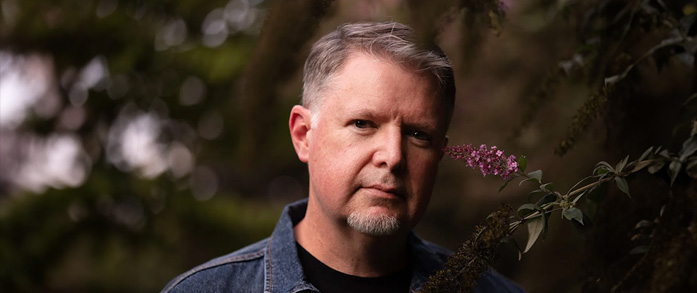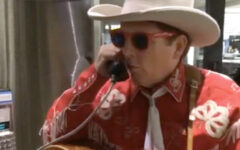
Milan Miller started learning guitar around the age of five. Guitar is his primary instrument, but he also plays the mandolin, bass, piano, and “just enough banjo and Dobro to get myself into trouble.”
Miller’s song catalog includes such Balsam Range staples as Calloway County Flood, Burning Georgia Down (written with Mark Bumgarner), Caney Fork River, Hard Price to Pay, The Other Side, Papertown, a song about the resilience of working people, I Ain’t Leavin’, A Day in the Life of a Railroad Spike, The Other Side of the Mountain, Chasing Someone Else’s Dreams, and I Spend My Days Below the Ground, a story about the hard life in a mining town that Miller co-wrote with Mark Bumgarner.
In addition he has written Pretty Little Girl From Galax and Little Magnolia (written with Adam Wright), both recorded by Russell Moore & IIIrd Tyme Out; Terry Baucom’s award-winning What’ll I Do (co-written with Mark W. Winchester), and Carry Me Back to Carolina; In A Perfect World (written with Glenn Simmons), recorded by Darren Nicholson; and The Boy From Valdese, a tribute to the late George Shuffler recorded with the aid of Shuffler’s brother Ron.
Two of these, Pretty Little Girl from Galax (in 2012) and Papertown (2013) were among IBMA’s final nominations for the Song of the Year award.
He moved to Nashville, Tennessee, in 1999 and he still resides there with his wife and their beagle, Little Sadie.
Since 2003 Miller has had his own home studio that he uses primarily for his own recording needs, but from time to time for work on projects for other artists also.
Other career highlights include numerous appearances on the Grand Ole Opry and being featured in Guitar Player magazine.
In February 2013, Miller released a solo CD, Poison Cove, which featured a dozen excellent songs.
Did you grow up in an environment where music was an important element?
“I grew up in Waynesville, NC, in the midst of the Great Smoky Mountains. The area has always been a breeding ground for traditional pickers and singers. My parents were not musicians, but they definitely were music lovers. The radio was always on and we went to see live music on a regular basis.”
When did you become aware of bluegrass music, and what were the circumstances?
“My introduction and eventual passion for bluegrass was a very gradual process. I started trying to play the guitar when I was about five years old, and took lessons for a few years from a gentleman named Bill Phillips. He was an accomplished musician on guitar, fiddle, and mandolin. Much of his teaching method was based upon classic songs from the first generation of bluegrass. Through those songs he helped me put a number of things in my musical tool belt that I still use today, including the importance of melody, timing, and how to compliment what the singer and other players are doing without being a distraction. When I look back upon that early training, I do have to admit that the content, emotion, and raw energy that contributed to the greatness of those songs may have been more than I could fully comprehend as a youngster. At the time, I was much more enamored by the songs that I was hearing on country radio.
Around the time that I went to college, a couple of artists really made an impression on me. One of the definite perks of attending Appalachian State University in Boone, North Carolina, was living in the same town as Doc Watson. I could never place a value on the experience of being able to see him perform in such informal and intimate settings, anywhere from the local flea market to the corner of a small family restaurant. My discovery of the Tony Rice catalog was also a big part of this period of my life. Obviously his guitar playing caught my ear, but it was his voice, the strength of the songs, and the impeccable arrangements that really held my attention.
After finishing college and just prior to heading off to Nashville, I moved back to my hometown. My friends Buddy Melton (of Balsam Range), Kevin Duckett, and Patrick Bradshaw were big fans of the newer bands that had popped up on the bluegrass scene. They introduced me to the likes of IIIrd Tyme Out, the Lonesome River Band, and the Lou Reid and Terry Baucom projects. It was during this period that I finally realized that bluegrass music could have just as much impact and drive as things with drums and electric instruments. Upon digging a little deeper I was really inspired by the work of folks like Hot Rize, the Seldom Scene, and Boone Creek. I eventually found my way back to Bill Monroe, Flatt & Scruggs, and the Stanley Brothers; many of the first tunes that I learned to play on guitar, only this time with a little more perspective and musical experience that helped me to understand the mastery behind those songs and recordings.”
That was an early age to start writing songs; what prompted you to do so and were there any early influences in this process?
“I don’t remember a time that I wasn’t interested in playing, singing, and writing. I wasn’t aware of who was writing the songs way back then, but the artists that really caught my ear were folks like Ronnie Milsap, the Statler Brothers, and definitely Buck Owens. I was so impressed by Buck that I even had a toy version of his red, white, and blue guitar, along with a pair of Hee Haw overalls.
I think that my initial reason for trying to write songs was probably out of necessity. I couldn’t play guitar well enough to play the songs that my favorite singers were doing, so I just made up my own.
OK, what was the first song that you had recorded (and by whom was that)?
“Balsam Range was kind enough to include two of my songs on their 2007 debut album, Marching Home. One was The Calloway County Flood, and another called Burning Georgia Down that I co-wrote with my old friend Mark Bumgarner. I really can’t say enough good things about Buddy Melton and the guys from Balsam Range. They went out on a limb and started recording my songs long before anyone else would even give them a listen.”
Tell me about the frustrations that you were experiencing at that time and about how you went about overcoming them, please.
“I actually think that the important thing for me was to not get frustrated. In a lot of ways, bluegrass artists are much more accessible than any other genre of music. As a result, they are often bombarded with material from every angle. When you consider the number of songs being written every day, getting something recorded is beyond a long shot.
Songwriting is no different than any other occupation. When trying to get a job it always helps to have relevant experience, a proven track record, and personal references. Relationships are often necessary to get a foot in the door, and that is exactly what my connection with the guys from Balsam Range provided for me. When things like Burning Georgia Down and Caney Fork River started getting played on the radio, it became a little easier to start a conversation with other artists.
I am still very much a newcomer, so when I have the opportunity to pitch songs to an artist, I do everything that I can to present my material in a professional manner. I have a small studio at my home and basic skills on a few different bluegrass instruments, so I have the ability to do demos that represent my songs in more of a full band format. I spend a fair amount of time studying the artist’s previous work, and then try to find things from my catalog that I feel have potential for fitting in stylistically. For good measure, I sometimes throw in a wildcard or two, just in case the artist is looking to change things up a little.
After I send songs to an artist, I have found that for me it is best not to ponder the situation any further. If someone wants to record a song, chances are I will get a call. If I don’t hear anything, then it is a safe assumption that nothing that I sent piqued their interest. To me, nothing good can come from repeatedly contacting the artist to get feedback about the songs. I’m pretty sure that no one wants to have to tell a songwriter why their song did not make the cut.
The other thing that I continue to learn when it comes to an artist choosing to record a song is the importance of timing. When someone passes on a tune for an upcoming project, it doesn’t necessarily mean that they did not like the song. Maybe they already had a song with a similar groove or sentiment, or for some other reason it didn’t fit with the particular group of songs that they already had assembled. There is always the chance that they may come back to it in the future.
A good example of this scenario is a song called I Spend My Days Below the Ground that I wrote with Mark Bumgarner. It is included on Five, the Balsam Range album that came out a few weeks ago. The song was written in 2004. Buddy Melton has had the demo since before they released their first album in 2007. When he called to tell me that it was going to be on their new record, it was a really nice surprise. I had not thought about the song in years, but a decade later it found a good home.”
Who were your main influences?
“A few years ago I finally began to realize that good ideas and a few good lines do not automatically result in good songs. To try and improve my understanding of the craft of song-writing, I started studying the work of writers like Jerry Salley and Carl Jackson. The balance between inspiration and song-craft that both of those guys display in their songs is impeccable. The rhymes are always tight, each line leads the listener toward the title and the melodies are always very catchy.
When it comes to authenticity, it is hard to beat Larry Cordle. He has such a natural way of turning phrases and telling stories. I’m also a big fan of Shawn Camp, Chris Stapleton, and Darrell Scott. I love how they aren’t afraid to push the music into new directions, but somehow always have a foot firmly planted in tradition.”







